Zalman HD-160 and Accompanying Products
by Joshua Buss on March 31, 2006 12:05 AM EST- Posted in
- Cases/Cooling/PSUs
HD-160 Case - Exterior and Interior
The HD-160 overall has a generous size. It's a little larger than most other HTPCs that we've looked at in the past, but it's still a manageble size that should work fine; whether or not additional components are included in a stack shouldn't be problematic for most users.
In addition to the vent on the top, this picture shows off one of the two sets of side vents, as well as the removable lid and two of the five screws that hold it in place.
The rear of the case is a bit more interesting, and shows a relatively strong resemblance to Thermaltake's Tenor chassis, reviewed in our last HTPC roundup. Dual 80mm system exhaust fans work in conjunction with the power supply to provide the entirity of the case's active cooling.
While external looks are certainly important, what really matters in an HTPC is the layout of the internal components. Without careful consideration, the components can overheat due to the demands for such a quiet environment, or worse yet, have problems physically fitting with other pieces of hardware. The good news is that the HD-160 has a thoughtful design and shouldn't suffer from any problems with most setups.
Perhaps the most prominent design mark is the vertical hard drive cage situated towards the front, which is a good idea for getting more available hard drives without having to make the case any larger. In addition to a single spot above the 5¼" drive, this leaves the HD-160 with a total of four internal hard-drive slots.
From a slightly different perspective, it's easier to see how the cage is positioned well, for instance cabling shouldn't be too difficult with the decent amount of space between the two removable cages.
Next, we'll examine the back of the case from inside, and upon doing so, we notice that many similarities can be drawn between this layout and a rather typical tower chassis that's simply been laid on its side.
With this observation, it's pretty safe to assume already that the cooling performance of the HD-160 is bound to be on par with other tower designs or, at the very least, among the best of HTPC cases. From a direct top-down view, this claim is even better substantiated, as the case has well-placed intake venting under the hard drives and under the area that wouldn't be blocked by any components.
The HD-160 overall has a generous size. It's a little larger than most other HTPCs that we've looked at in the past, but it's still a manageble size that should work fine; whether or not additional components are included in a stack shouldn't be problematic for most users.
In addition to the vent on the top, this picture shows off one of the two sets of side vents, as well as the removable lid and two of the five screws that hold it in place.
The rear of the case is a bit more interesting, and shows a relatively strong resemblance to Thermaltake's Tenor chassis, reviewed in our last HTPC roundup. Dual 80mm system exhaust fans work in conjunction with the power supply to provide the entirity of the case's active cooling.
While external looks are certainly important, what really matters in an HTPC is the layout of the internal components. Without careful consideration, the components can overheat due to the demands for such a quiet environment, or worse yet, have problems physically fitting with other pieces of hardware. The good news is that the HD-160 has a thoughtful design and shouldn't suffer from any problems with most setups.
Perhaps the most prominent design mark is the vertical hard drive cage situated towards the front, which is a good idea for getting more available hard drives without having to make the case any larger. In addition to a single spot above the 5¼" drive, this leaves the HD-160 with a total of four internal hard-drive slots.
Next, we'll examine the back of the case from inside, and upon doing so, we notice that many similarities can be drawn between this layout and a rather typical tower chassis that's simply been laid on its side.
With this observation, it's pretty safe to assume already that the cooling performance of the HD-160 is bound to be on par with other tower designs or, at the very least, among the best of HTPC cases. From a direct top-down view, this claim is even better substantiated, as the case has well-placed intake venting under the hard drives and under the area that wouldn't be blocked by any components.


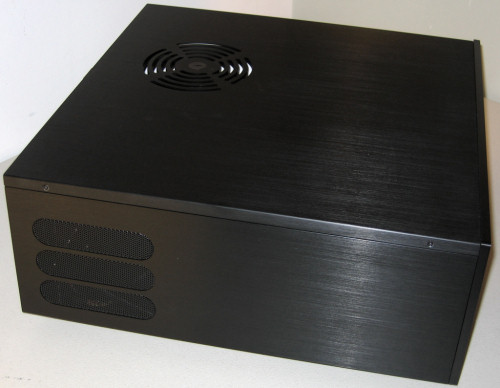
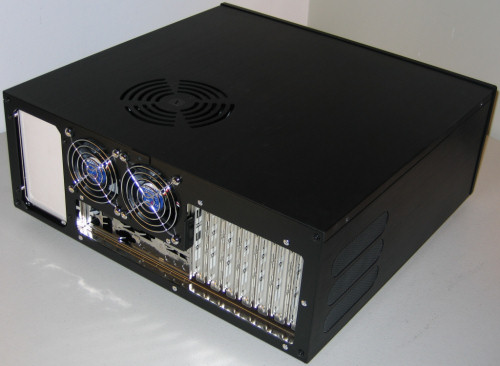
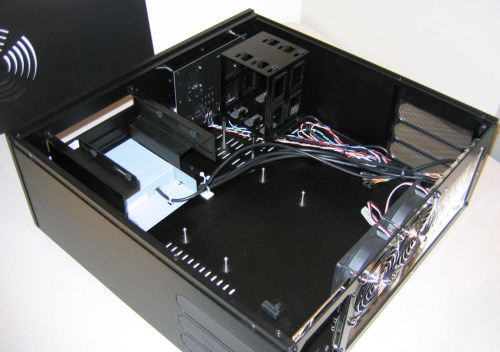

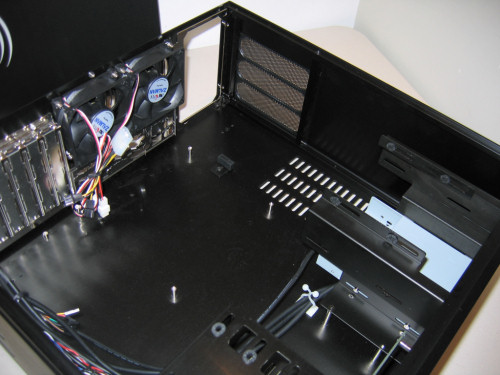
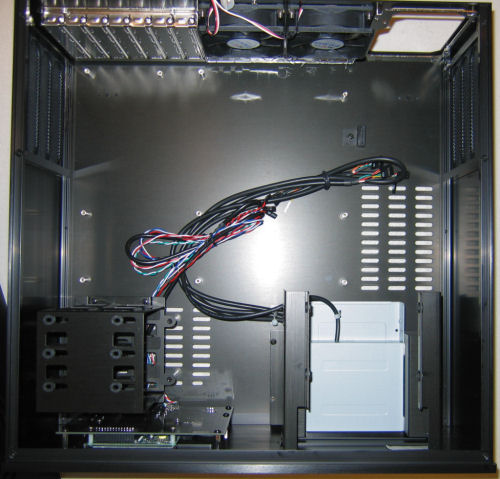








48 Comments
View All Comments
SonicIce - Saturday, April 1, 2006 - link
yeah i was just joking around man. you did a good job reviewing it the way you did.JoshuaBuss - Monday, April 3, 2006 - link
Thanks man, I never am sure on these little 'comments' sections.. I tend to get a lot of crap here.. haha.I kinda guessed that you were joking actually, but wanted to take the time to clarify why exactly I cable it the way I do anyway. I suppose for a lot of people, they might've read your post and NOT thought it was meant in jest.
4AcesIII - Friday, March 31, 2006 - link
Thermaltake's Mozart and Bach cases have that thing beat hands down at less money. And why not tell us that the vfd and remote are farmed out to Imon by Soundgraph? Anyone notice how the vid cooler eliminates use of slot next to video? If you're going to do that why not get something that puts the hot air out the back like some other after market vid coolers do? This is nothing other than a big black box with alot of stuff bought from others to put into and with it and not especially attractive either but that sorta follows Zalman's history in my opinion. Go ahead and buy it if you want a Yugo get something else if you want quality.segagenesis - Friday, March 31, 2006 - link
I think this is the HTPC case I've been waiting for. Screw how big it is... I want as quiet as possible.topher42 - Saturday, April 1, 2006 - link
Take a look at the OrigenAE X11.ScarletGrayFire - Friday, March 31, 2006 - link
It's about time we have an HTPC case capable of quietly cooling a high-performance HTPC! This case fits right in the audio rack, and with three 80mm fan locations and enough room for a quiet CPU HSF, one can run an Athlon FX CPU with a state of the art video card. Also, an Arctic cooling vga cooler will push some of the heat in the PCI card area out the back of the case. Word is that this case is actually manufactured by OrigenAE.mbhame - Friday, March 31, 2006 - link
Those pictures are awful. What gives??JoshuaBuss - Friday, March 31, 2006 - link
care to elaborate? any particular pics? I thought most turned out very good actually..?Howard - Friday, March 31, 2006 - link
It's spelled "exemplary", and I only see 3 discrete copper heat pipes (re: Zalman 9500).JoshuaBuss - Friday, March 31, 2006 - link
Thank you. I don't know what I was thinking.. I knew it was three all along..heh.